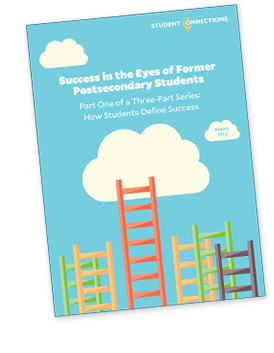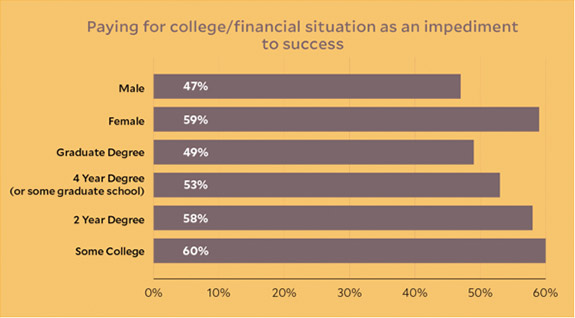|
||
|
Successes and Setbacks: What Students Say Are the Biggest Factors in College Outcomes |
||

|
||
Below is a summary of some key findings. You can download a whitepaper with a more thorough summary here. How Students Define Success Overall, students measure success by two principal outcomes: earning a stable income and doing what makes them happy in life. They expect college to be a bridge to a lifestyle that is both personally and professionally rewarding so that they can support the needs of themselves and their families while feeling fulfilled in the pursuit of their life’s work. Obstacles on the Road to Student Success Financial concerns are the biggest threat to completing school and becoming successful. Although the problem was common among all student groups, responses show it was more acute for students who did not advance as far along the academic path. This confirms the potential that financial literacy skills have for boosting retention and completion and for default prevention. Empowering Student Success Students indicated that goal setting, independent learning and time management contributed the most toward their success. We also asked students which soft skills were most important to their success, and how they preferred to be exposed to them. They clearly valued the classroom setting; however, for certain skills, many students showed a preference for building competencies through an online or app-based resource, especially those who attended classes more recently. Meanwhile, students expect to build important nonacademic skills before they begin college. However, this expectation often is not met. But postsecondary institutions that don’t have the resources to meet practical skills gaps in the classroom or through other face-to-face engagement can use flexible learning platforms to help students. Such an approach can allow students to build practical skills key to their success within the independent learning environment they clearly favored in their responses to this survey. Information about how students appraise postsecondary outcomes can only improve the impact of student engagement. Our survey reflected several other links between student circumstances and how success, challenges and resources are perceived. To read the complete summary of the student survey, click here to download the white paper. |
||
|
|
||
 |
| This e-mail was sent to: [EMAIL]. One Click Unsubscribe | Manage My Subscriptions [COPYRIGHT] 35 Nutmeg Drive Suite 205, Trumbull, CT, 06611 |
![[image] University Business logo](http://www3.universitybusiness.com/mailing/logos/ublogoNEW.png)

